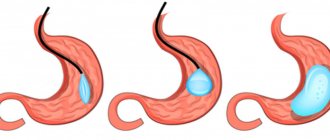Causes of gynecomastia in men
The development of breast tissue depends on the influence of sex steroids. Normally, a man's body produces estrogens and testosterone, but their ratio differs from that of women in favor of androgens. The main mechanisms of changes in hormone concentrations are associated with the following factors:
- excessive synthesis of estrogen, more often observed in tumor tissues;
- violation of hormone inactivation, occurs in liver pathology;
- changes in steroid metabolism.
If in adolescents gynecomastia can be associated with physiological changes in the body and maturation, then in men the cause of the condition is most often pathological deviations in the balance of estrogen. Their concentration exceeds the norm, sometimes several times, in the following cases:
- estrogen-producing Leydig cell tumors in the testes;
- taking steroid hormones to increase muscle mass and create body contour;
- treatment with certain groups of drugs;
- use of opiate drugs.
Treatment with cytostatics, antidepressants, antifungals and some antiviral drugs used for HIV infection can lead to gynecomastia in men. “Excess estrogen leads to the development of mammary gland tissue in men and the development of gynecomastia. As a rule, this happens in the case of teenage hormonal disorders, obesity and taking anabolic steroids!” A relative imbalance of hormones can cause the development of gynecomastia in an adult man. In this case, the concentration of estrogen remains normal, but their relationship with progesterone is disrupted. This is possible in the following conditions:
- age-related changes in the structure of the testicles, physiological decline in testicular function;
- liver diseases that impair its function, including cirrhosis;
- patients with renal failure who regularly undergo hemodialysis;
- hypogonadotropic hypogonadism – testosterone synthesis is inhibited, but estrogen is retained;
- endocrine diseases - hyperthyroidism, hyperprolactinemia.
Obesity, especially in older men, often also leads to the development of gynecomastia.
Fat deposits according to the android (male) type
Android obesity is characterized by the accumulation of excess fat in the abdominal and torso areas - but is not limited to men.
This obesity is more common among men than among women and this phenotype manifests itself with age. This obesity and local fat deposits on the abdomen are often said to be gender-linked and characterized by the fact that relatively little fat accumulates in the lower torso. But a disproportionate amount accumulates in the abdominal region (forming the classic “beer belly”) or in the upper torso. While android obesity is often considered a phenomenon that occurs in males (as the name suggests), this is not always the case.
Women also experience android obesity, most often after menopause when estrogen levels drop. Android obesity is also associated with individuals (both male and female) who are exposed to chronic stress. Our internal response to long-term stress is a key factor in where fat deposits appear in our bodies - on the stomach, back, arms, regardless of gender.
Thus, women whose stress hormone (cortisol) is higher than normal tend to accumulate fat according to the android type. Women with above average levels of male hormones (androgens). They can also deposit adipose tissue in a male pattern and an interesting fact is that the displacement of local fat deposits in men from the lower part of the body (especially the abdomen, gluteal-femoral region) is partly caused by the action of the male hormone testosterone, this is one of the reasons why some women use steroids.
Signs of gynecomastia in men
In adulthood, a man notices that one or both mammary glands begin to increase in size. More often the process begins in the area around the nipple of the areola. They protrude above the surface of the chest.
Men with gynecomastia may complain of breast tenderness and engorgement, but this is not necessarily a sign. The skin in the area of pathological enlargement remains healthy, there is no discharge from the nipple. Most men find it difficult to answer how long this condition lasts.
Gynecomastia in most cases accompanies other diseases or is their consequence. Therefore, additional symptoms may be of concern:
- decreased libido;
- deterioration of erection;
- female type of fat deposition;
- infertility.
“When diagnosing gynecomastia, the doctor must determine the leading factors that caused the disease.”
Gynecomastia does not threaten a man’s life; more often it is a cosmetic defect. But with unilateral breast enlargement, with the appearance of discharge, changes in the skin over the tumor, the likelihood of a malignant process is high.
Gynecomastia in men on ultrasound
Gynecomastia can be suspected upon examination and palpation of the mammary gland. But to confirm the diagnosis, an ultrasound examination is necessary. Ultrasounds are performed for men with gynecomastia at any convenient time, unlike women with breast pathology.
Special preparation for ultrasound for gynecomastia is not required. The patient is examined alternately in a supine position with arms thrown back and sitting. The ultrasound probe is carried out in a fan-shaped manner in the direction from the areola to the periphery of the mammary gland. All sectors of the chest are sequentially examined, imagining it as a conventional dial.
After examining the breast parenchyma, they proceed to assessing the areola. It is quite dense, so it does not transmit ultrasonic waves well. To study the tissue behind it, the sensor is installed on the side and the rays are directed into the subareolar space.
An ultrasound of the mammary gland is concluded by examining regional lymph nodes located in the supra- and subclavian, axillary regions and in the parasternal lines. This eliminates the possibility of metastases from malignant tumors.
Ultrasound evaluates the structure of a neoplasm in the mammary gland according to standard criteria. Gynecomastia is a nodular formation that is clearly visualized using ultrasound. During the examination, the doctor can determine the shape, size, spatial orientation and location of the node. The following features are characteristic of gynecomastia in men:
- the node is located in the retroareolar region or in the subcutaneous fat of the breast;
- the shape of the node is often polygonal, but there are ovoid, flat, ellipsoidal variants;
- the contours of the node may be unclear, echogenicity is reduced;
- the structure of the node is heterogeneous due to isoechoic and hyperechoic areas in the form of linear, point formations, but they do not have signs of pathological inclusions. Hyperechoic areas are areas of fibrous tissue;
- with gynecomastia, the ducts of the gland are rarely visualized; microcalcifications and cystic cavities are sometimes encountered.
Dopplerography for gynecomastia and color Doppler mapping are uninformative and not indicative. The vessels can be located either intranodular or perinodular. Gynecomastia is characterized by venous blood flow, but sometimes arterial blood flow occurs.
“When examining men with gynecomastia, mammography is not used. This method is not very informative due to the structural features of the neoplasm and its localization behind the nipple.”
Additional diagnostics for gynecomastia
Gynecomastia in men is accompanied by diseases of the endocrine system and internal organs. Therefore, during the examination it is necessary to find the reasons for the appearance of the node. When you first visit a doctor, the external genitalia are examined. If gynecomastia is associated with insufficient testosterone production, the doctor may detect testicular hypoplasia or, conversely, their enlargement due to the formation of a tumor.
Laboratory diagnosis includes determination of hormone concentrations. The attending physician individually determines which indicators the patient needs. It can be:
- testosterone;
- estradiol;
- progesterone;
- hCG;
- prolactin;
- luteinizing hormone;
- cortisol;
- thyroid hormones.
The cause of gynecomastia in a man must be sought in order to reduce the likelihood of relapse of the disease. Therefore, they may additionally prescribe a CT or MRI of the brain, ultrasound of the abdominal cavity and thyroid gland, and a biochemical blood test.
To determine the morphological characteristics of the node tissue, a biopsy is performed under ultrasound guidance.
Hormones responsible for weight change
Hormones such as epinephrine, norepinephrine, glucagon, ACTH, melanocyte-stimulating hormone, growth hormone and vasopressin accelerate the release of free fatty acids from adipose tissue and increase their concentration in the blood plasma, increasing the rate of triglyceride lipolysis.
An increase in body weight may be due to a violation of the synthesis or production of biologically active substrates involved in the regulation of eating behavior. The most important monoamines and peptides that provide a balance between the feeling of hunger and satiety: orexigenic effects - norepinephrine (α2 receptors), neuropeptide-Y, β-endorphin, somatoliberin, galanin, ghrelin, somatostaitin; anorexigenic effects: norepinephrine (α1-, β-2 receptors), serotonin, cholecystokinin, melanocyte-stimulating hormone, corticoliberin, leptin, enterostatin, glucose, thyrotropin-releasing hormone, vasopressin, bombensin)
Standard laboratory and instrumental studies for obesity include a set of definitions:
- Lipid spectrum of blood,
- fasting blood glucose, OGTT if necessary,
- ALT, AST, GGTP, ALP, uric acid, creatinine,
- Blood pressure measurements,
- ECG,
- Ultrasound OBP,
- In all patients, hypercorism should be excluded by any of the following methods: excretion of 24-hour urinary cortisol, overnight suppressive test with 1 g of dexomethasone (small desamethasone test), assessment of the level of cortisol in saliva,
- Assessment of thyroid function TSH,
- Determination of the level of total, ionized calcium, 25(OH)D and PTH to diagnose vitamin D deficiency and exclude SHPT.
Classification of gynecomastia in men
Already during an ultrasound of the breast, the type of gynecomastia can be determined. In clinical practice, several classifications of pathology are used. Depending on the tissue origin, the following types of pathology are distinguished:
- true - formed from the lobar milk ducts and hypertrophied fibrous tissue;
- false – it is based on hypertrophy of adipose tissue;
- mixed - the formation of a pathological node occurs due to adipose and fibrous tissue.
Based on histological examination, it is possible to determine the stage of development of gynecomastia and draw up a treatment plan for the patient. The following stages of node formation are distinguished:
- proliferation - at the initial stage, changes in the mammary gland are reversible, therefore conservative treatment is effective. The stage lasts up to 4 months;
- intermediate stage - connective tissue matures in the node, it compacts the structure. The duration of the intermediate period is up to 1 year;
- fibrosis - a node has formed, there is a lot of connective tissue in it, fatty tissue is deposited around the glandular tissue. Regression of the disease is impossible.
When classifying the degree of mammary gland enlargement in men, the size of the areola and its relationship with the node are taken into account. There are 4 degrees of gynecomastia:
- There is minimal nodularity under the areola.
- The diameter of the node is smaller than the areola.
- The size of the node is equal to the diameter of the areola.
- The tumor is larger than the areola.
Also, based on a histological examination, the doctor receives confirmation of the benign nature of the neoplasm. But in conclusion, the degree of proliferation of the epithelium can be described, by which one can judge the likelihood of developing a malignant neoplasm. If proliferation is not observed, then the risk of developing breast cancer in a man with gynecomastia is increased by 1.5 times compared to a healthy person. When foci of proliferation are detected, the probability of developing a malignant tumor increases up to 1.9 times. In the case of atypical proliferation, the risk of breast cancer increases by 3-25 times.
Fat deposits on the human body
Why do people store fat on different parts of their body?
The most infuriating fact about losing weight is that the fattest areas are the hardest to lose fat. They stubbornly resist the most diligent attempts to get into shape. Trying to lose fat can take months, if not years, while other people have absolutely no fat traps in similar areas of the body. Around the world, three hundred million people have what can be characterized by the medical term “clinical obesity” and only one Russian out of three is slightly above ideal, but even those citizens who are in relatively good physical shape have fat deposits on their certain areas of the body - under the arms, in the lower abdomen, on the thighs, around the waist and on the buttocks, which makes them very worried about their appearance.
In fact, almost no one is immune from the accumulation of fatty tissue in such a problem area, which is difficult to remove. This is a very demoralizing dilemma, especially for women, and someone with a cool head is bound to urge them to spend their hard-earned money on vibration machines, anti-cellulite massages and fat trap creams - all in the hope of getting rid of localized fat deposits on the stomach and back.
In this article, we'll look at the reasons why people store fat in different areas of the body in so many different ways, and examine the environment, diet, and genetic factors that play a major role in how and where our bodies gain weight. Thank you for reading my articles and please share them with those who may benefit from them.
Treatment of gynecomastia in men
The doctor chooses a treatment method depending on the causes of the pathology and the stage of gynecomastia. If the node is still at the proliferation stage, it can be eliminated conservatively. To do this, it is necessary to find the cause of absolute or relative hyperestrogenism.
An endocrinologist can be involved in the treatment of gynecomastia. In patients with thyroid diseases, it is necessary to monitor and adjust hormone levels. In case of alimentary obesity, the diet is adjusted, and sometimes medications are prescribed to control appetite or the absorption of carbohydrates and lipids.
“If gynecomastia has developed due to the use of medications, the use of anabolic steroids, for successful treatment it is necessary to discontinue or replace the drugs with safer ones.”
But given that most men do not seek medical help when the first signs of gynecomastia appear, conservative treatment becomes impossible. Therefore, the main method of treating gynecomastia in men is surgery.
Surgery for gynecomastia in men
Gynecomastia is a benign formation that rarely leads to the development of complications in men. Therefore, the main indication for surgery is a cosmetic defect that causes psychological discomfort to the patient.
Preparation for surgery is carried out according to the standard procedure. An examination for HIV, syphilis, hepatitis, an ECG, a clinical examination of blood and urine is required. Diagnostics are carried out to determine contraindications for surgery and the patient’s condition.
The operation is performed by subcutaneous mastectomy if true gynecomastia is diagnosed. For patients with false gynecomastia, the doctor may suggest performing liposuction and removing fat tissue in a minimally invasive way. But this method is accompanied by frequent relapses, especially in patients who have not eliminated the cause of the pathology.
For mixed types of gynecomastia, a combination of liposuction and mastectomy can be used. This increases the likelihood of a favorable outcome and reduces the chances of relapse. In advanced forms of gynecomastia, when a large nodule has formed and the skin on the mammary gland has stretched, the operation is carried out in 2 stages - first the nodule is removed, then breast plastic surgery is performed.
To remove fatty tissue, 2 punctures on each side of the mammary gland are enough. But the node with gynecomastia is quite dense, it cannot be aspirated. Therefore, for a mastectomy, an incision is made under the areola, equal to ¼ of its circumference. Through it, the node is carefully isolated and separated from the surrounding tissues.
“To exclude a malignant tumor, it is necessary to send the removed material for histological examination.”
Nutrition for obesity
Fasting for obesity is contraindicated!
The minimum daily calorie intake should be at least 1500 kcal for men, 1200 kcal for women. The balance of main macronutrients is distributed as follows: fat intake 25-30% (saturated fat less than 10%), protein 15%, carbohydrates 50-60%,
The daily caloric intake should be distributed over 3 main and 2 additional meals (research has proven that with any diet, eating twice a day during the day leads to significantly greater weight gain than more frequent meals with the same caloric content of the daily diet).
Separate fluid intake from meals 30 minutes before or after meals.
The diet is compiled taking into account the patient’s body weight, age, gender, level of physical activity and food preferences. Limiting the need for fat to 25% of daily calories, animal fats to no more than 10% of the total amount of fat, cholesterol to 300 mg per day (The most cholesterol-rich food: offal (heart, tongue, liver, kidneys, offal and especially brains), salmon caviar and sturgeon fish, egg yolk, butter and ghee, crabs, shrimp, fatty meats, fish and cheeses, lard). You should also limit the consumption of quickly digestible carbohydrates and introduce large amounts of fiber into your diet. It should be noted that moderate consumption of vegetable fats in their natural form is even beneficial, as it helps the resorption of atherosclerotic plaques
Recovery after surgery
In the first few days after the operation, you will be bothered by pain in the mammary gland and its swelling. But they go away if you use compression garments for 2 weeks. To reduce pain, non-steroidal anti-inflammatory drugs are prescribed.
Complications after surgery are rare. In the first 3 weeks there is a risk of breast seroma formation. Therefore, periodic observations by a mammologist are recommended. Bruising after surgery for gynecomastia goes away on its own and does not require special treatment.
A rare complication is impaired blood flow or lymphatic drainage in the breast and areola area. If the doctor follows the surgical technique, these undesirable effects are excluded.
Rough scars form in patients prone to keloid formation. In older men, surgery does not always provide a good cosmetic effect. Therefore, subsequent plastic surgery may be required.
Prevention and prognosis
For men diagnosed with gynecomastia, the prognosis is favorable. The development of a malignant breast tumor occurs in only 1% of patients. After treatment, if the doctor’s recommendations are followed and the underlying disease is treated, the re-formation of gynecomastia in men does not occur.
To prevent hypertrophy of breast tissue, it is necessary to exclude factors in life that cause relative or absolute hyperestrogenism. To do this, men need to adhere to proper nutrition, not abuse alcohol, and not use drugs. For those involved in bodybuilding, the use of anabolic steroids should be approached with caution or not.
Stress affects the state of the hypothalamic-pituitary system, which regulates the activity of the gonads. Therefore, against the background of constant mental stress, hormonal problems may worsen.
At our Mammology Center, doctors have extensive experience in diagnosing and treating gynecomastia in men. We use modern ultrasound machines to diagnose pathology as accurately as possible. You can make an appointment by calling the numbers listed on the website or using the feedback form.
Classification: types of karyotypes in Klinefelter syndrome
Based on the number of additional X chromosomes, the following variants of Klinefelter syndrome are distinguished:
- 47,XXY - the most common
- 48,ХХХY
- 49,XXXXY
In addition, Klinefelter syndrome also includes male karyotypes that include, in addition to additional X chromosomes, an additional Y chromosome - 48,XXYY . And finally, among patients with this syndrome there are individuals with a mosaic karyotype 46,XY / 47,XXY (that is, some of the cells have a normal chromosome set).











